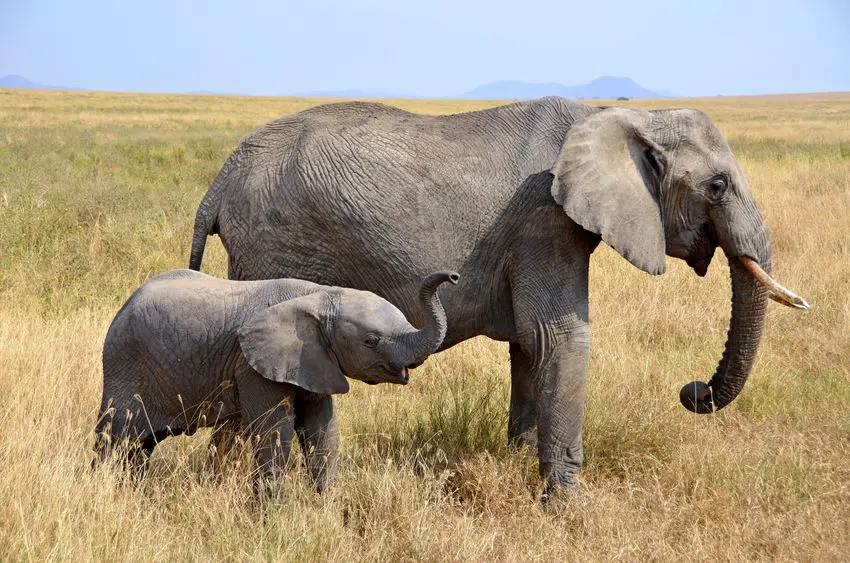
African elephants are some of the most well-known and beloved animals in Africa and thousands of safari tourists go to Africa every year hoping to see them and that is for a very good reason. African elephants are some of the most unbelievable and magnificent animals in the entire world and there are tonnes of fascinating and surprising facts about them.
Below, you can find 61 of the most interesting and fun facts about African elephants.
- Elephants can produce sounds that are so deep that humans can’t hear them. These sounds can be heard by other elephants several miles away and are used to keep each other oriented about where they are.
- African elephants can feel small vibrations in the ground with their feet and know about incoming thunder, which often means rain and therefore fresh, green vegetation.
- An African elephant’s canine teeth can weigh almost 9 lb (almost 4 kg) each.
- African elephants use their ears to cool down. They have a large number of blood vessels in their ears and when they wave them, some of the heat from the blood is carried away.
- An African elephant’s heart can weigh up to 62 lb (28 kg).
- A common cause of death for African elephants is that their teeth become so worn out after years of chewing tonnes of plants that they lose their ability to chew food and thereby obtain nutrients.
- African elephants are the largest land-living animals in the world.
- African elephants belong to the Elephantidae family of animals.
- African elephants have a lifespan of 70 years in the wild and 17 years in captivity.
- The life expectancy of African elephants is 50-65 years depending on the region.
- There are 3 stages in the life cycle of an African elephant; the baby stage (lasts until age 5-10), adolescence (lasts until age 18-20), and adulthood.
- A group of elephants is called a Herd.
- Female African elephants are social creatures that usually stay in groups of 10-12.
- The females in a herd are usually related to each other and usually include mothers, grandmothers, aunts, cousins, sisters, and calves.
- Fully grown male African elephants are typically solitary animals but can sometimes stay in temporary groups with other males.
- The gestation period of African elephants is 21-22 months.
- African elephants almost always have 1 calf but can have twins about 1% of the time.
- African elephant calves weigh 200-265 lb (90-120 kg) at birth.
- African elephant calves are covered in long hairs all over their bodies that serve the purpose of carrying heat away from the calves’ skin to help them stay cold and not overheat.
- African elephant calves begin to learn to walk within a few hours of being born.
- Young African elephant calves are clumsy and sometimes trip and fall over their own trunk.
- Newborn calves drink around 4 gallons (15 liters) of their mother’s milk every day.
- Calves grow by around 2.2 lb (1 kg) per day.
- The tusks begin to appear within the first year of an African elephant’s life.
- If a calf loses its mother, another female elephant from its herd can adopt it and raise it as if it was her own.
- African elephants reach sexual maturity around the age of 10-13.
- Female African elephants stay in their herd for their entire lives.
- Male African elephants leave their herd when they reach adolescence.
- Young males that have left their herd will often seek out other young males and form temporary groups of up to 100 male elephants.
- Male African elephants from around age 25 and up will occasionally come into musth. When they are in musth, they have only one focus; seeking out females for mating.
- During musth, male elephants’ testosterone levels are much higher than normally and they become much more aggressive.
- African elephants can be found in most sub-Saharan African countries.
- The primary habitats of African elephants are savanna, forest, grassland, shrubland, wetlands, and deserts.
- The conservation status of African elephants is vulnerable.
- There are around 415,000 African elephants left in the wild according to IUCN.
- According to WWF, tens of thousands of elephants are killed by poachers every year.
- The overall population of African elephants is increasing, mostly in the southern regions of Africa.
- Fully grown elephants have very few natural enemies because of their size, strength, and thick skin.
- Mostly calves, young elephants, and very old, sick, or otherwise weak elephants are at risk of being hunted by predators.
- The primary natural enemies of African elephants are lions and humans.
- Sometimes smaller predators such as hyenas, African wild dogs, and crocodiles can try to kill a small elephant calf.
- When a herd of elephants is under attack from predators, they will form a defensive circle with the strong elephants on the outside and the young or weak on the inside for protection.
- African elephants are herbivores that eat branches, grass, bark, berries, fruits, and other plants.
- African elephants eat for up to 16 hours per day.
- African elephants can consume plants equal to up to 5% of their body weight per day. For the large bulls, this amounts to 660 lb (about 300 kg) of plants per day.
- African elephants drink around 42 gallons (160 liters) of water every day.
- Male African elephants generally have larger tusks than females.
- African elephants use their tusks for debarking trees, moving things around, and digging for water.
- African elephants can also use their tusks for combat and self-defense by trying to impale attackers.
- The tusks on an African elephant can grow up to 6.7 in (17 cm) per year.
- The largest tusk from an African elephant ever measures was 10.76 ft (328 cm) long and weighed 286 lb (130 kg).
- An African elephant’s tusks grow for the elephant’s entire life.
- African elephants are left or right-tusked, just like humans are left or right-handed. The dominant tusk is often slightly shorter than the other one due to wear and tear.
- African elephants use their trunks to break branches and pick leaves to eat.
- African elephants can lift up to 1100 lb (500 kg) with their trunks.
- There are more than 100,000 muscles in an African elephant’s trunk.
- Male African elephants weigh 8,800-14,300 lb (about 4,000-6,500 kg) and females weigh 8,800-14,300 lb (about 4,000-6,500 kg).
- African elephants can be up to 13.1 ft (4 meters) tall.
- African elephants can get up to 24 ft (7.3 meters) long.
- African elephants’ tails are 3.3-5 ft (1-1.5 m) long.
- African elephants can run 25 mph (40 kph).
If you like these facts and you are curious about African elephants and want to learn more, head over to this page where you can find all our posts about them.
